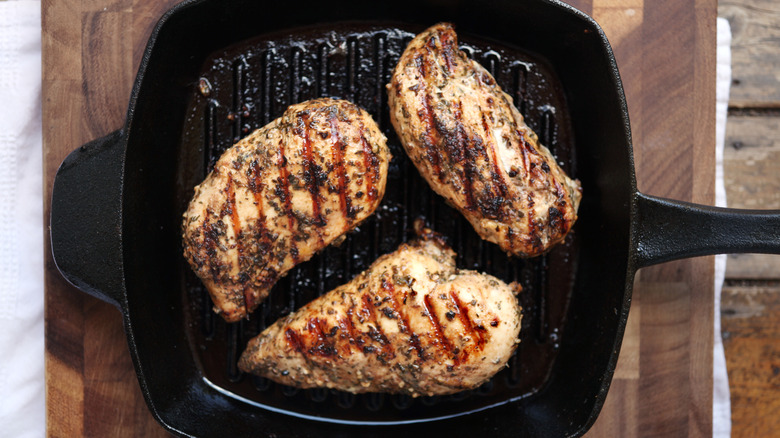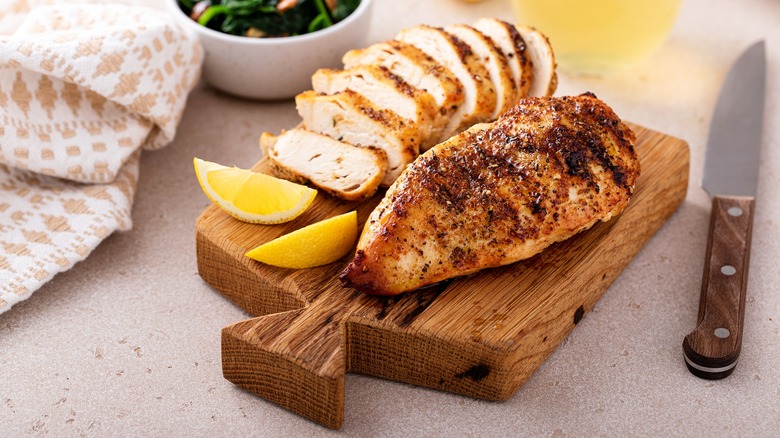The Reason Ina Garten Undercooks Her Chicken Breast
While cooking steak to different levels of doneness is the norm, the same can't be said for chicken. Even those who aren't confident in their cooking skills likely know, at the very least, that even simple mistakes like undercooking raw chicken present a risk for salmonella. Considering she's a celebrity chef with an impressive array of TV shows and cookbooks, you probably wouldn't expect Ina Garten of all people, to undercook her chicken. But as she revealed in an Instagram reel, she does so entirely on purpose, and relies on the residual heat to cook it the rest of the way.
The reason for this isn't, of course, that Garten doesn't care about salmonella, but rather that she wants her chicken to turn out as juicy as possible. When properly executed, her method ensures the chicken doesn't get any higher than 165 degrees Fahrenheit, which is the minimum temperature the meat has to reach in order for it to be safely consumed. The longer you cook chicken, the higher its temperature will be, and the drier it will turn out.
There's a right and wrong way to undercook chicken breast
Ina Garten may technically undercook her chicken breast, but there's a specific method she follows in order for it to reach a safe temperature before serving. Her technique, originally published in her cookbook "Barefoot Contessa: At Home," starts with baking the chicken in a 375-degree Fahrenheit oven. She leaves it there just before it's about to finish, when the internal temperature reads 155 to 160 degrees Fahrenheit with a meat thermometer. What follows is perhaps the most important step — immediately after taking the chicken out of the oven, she covers the baking pan in aluminum foil for 10 minutes, allowing the chicken to reach the last 5 to 10 degrees needed for it to achieve complete doneness.
If you take out your chicken when it's internally any lower than 155 degrees Fahrenheit, it may not become fully cooked after resting. This may also end up being the case if you were to skip the foil tenting step, since foil helps to retain heat. For best results, consider using an instant-read thermometer, which makes determining the correct temperature a breeze. (And no, probing your meat won't ruin it.) In her cookbook, Garten also notes that you can go off of the time and appearance of the chicken when estimating doneness. The skin should have some light browning and take roughly 35 to 40 minutes in the oven to come to temperature.
How safe is Ina Garten's method?
Ina Garten's hack for achieving juicy chicken might raise concerns about food safety, but it's actually supported by scientific principles. What occurs after the chicken is taken out of the oven is known as carryover cooking. Here's how it works: When the chicken is removed from the oven, the exterior is typically hotter than the interior due to the direct heat exposure. Heat naturally flows from hotter regions to cooler ones until thermal equilibrium is reached. So even though the chicken doesn't finish cooking in the oven, it does finish cooking through thermodynamics. Just make sure your bird reaches 165 degrees Fahrenheit, and you can assume it'll be safe to consume.
Carryover cooking can cause the temperature of poultry to rise by 10 degrees, but if you're worried about how effective it is, you can always opt to remove your chicken from the oven closer to 165 degrees. There's no reason for concern when following Garten's approach, just as long as you pay close attention to the temperature.


